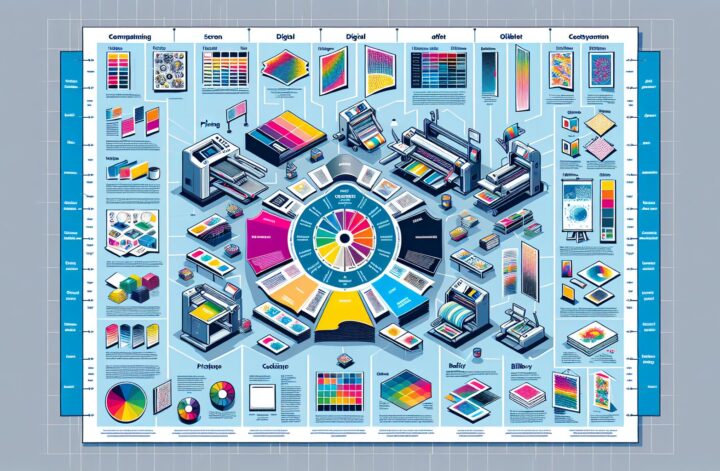When it comes to printing, choosing the right material is crucial for achieving high-quality results. Whether you’re printing marketing materials, personal projects, or professional documents, the material you select can make a significant difference in the final product. In this guide, we will explore various printing materials available in the market, their characteristics, and what factors to consider when choosing the perfect material for your printing needs.
Understanding Printing Materials
Printing materials can be broadly categorized into three types: paper, synthetic materials, and specialty materials.
1. Paper
Paper is the most commonly used printing material due to its versatility and affordability. It comes in numerous finishes and weights, offering a wide range of options to suit different printing requirements. Here are some popular types of paper:
- Plain Paper: Plain paper is the most basic type and is commonly used for everyday printing needs. With a smooth finish, it is ideal for printing documents with minimal graphics or images.
- Coated Paper: Coated paper has a smooth, glossy finish and is suitable for printing high-quality images and vibrant colors. It is commonly used for brochures, catalogs, and marketing materials.
- Matte Paper: Matte paper provides a non-glossy finish, making it suitable for printing documents requiring a professional look without the glare. It is often used for presentations, reports, and photographs.
- Recycled Paper: With increasing environmental concerns, recycled paper has gained popularity. It is made from post-consumer waste and offers a sustainable option for printing projects.
- Cardstock: Cardstock is a heavyweight paper that provides durability and stiffness. It is commonly used for printing business cards, invitations, and postcards.
2. Synthetic Materials
Synthetic materials offer durability and resistance to water, tearing, and fading. They are ideal for situations where printed materials need to withstand harsh conditions or have a longer lifespan. Let’s explore some commonly used synthetic materials:
- Vinyl: Vinyl is a versatile synthetic material that can withstand outdoor conditions. It is commonly used for banners, signs, and decals due to its durability and weather resistance.
- Polypropylene: Polypropylene is a flexible, tear-resistant material suitable for indoor and outdoor applications. It is often used for banners, posters, and packaging materials.
- Polyester Film: Polyester film offers excellent clarity and durability, making it perfect for printing stickers, labels, and overlays. It can withstand exposure to high heat and is resistant to tearing.
- Tyvek: Tyvek is a tough, high-density polyethylene material known for its strength and water resistance. It is commonly used for printing wristbands, tags, and envelopes.
3. Specialty Materials
Specialty materials are designed to meet specific printing requirements or create unique effects. They often offer unique textures, finishes, or visual effects that can enhance the overall appearance of the printed material. Let’s explore a few examples:
- Foil Paper: Foil paper adds a metallic finish to printed materials, giving them a luxurious and eye-catching appearance. It is commonly used for business cards, invitations, and certificates.
- Magnetic Paper: Magnetic paper is coated with a magnetic backing, allowing it to adhere to metallic surfaces. It is commonly used for creating personalized magnets or promotional materials.
- Carbonless Paper: Carbonless paper is coated with chemicals that create copies without the need for carbon sheets. It is commonly used for printing invoices, receipts, and other multipart forms.
Factors to Consider When Choosing Printing Materials
Selecting the right material for your printing project involves considering various factors. Here are some key aspects to keep in mind:
1. Purpose and Usage
Consider the purpose and usage of the printed materials. Are you printing brochures, business cards, or outdoor banners? Different materials offer varying degrees of durability, weather resistance, and longevity.
2. Image Quality and Color Vibrancy
If high-quality images and vibrant colors are essential, consider using coated paper or synthetic materials with a glossy finish. These materials enhance the image quality and color vibrancy, ensuring your graphics or photographs stand out.
3. Paper Weight and Thickness
The weight and thickness of the material play a significant role in the perceived quality and durability of printed materials. Thicker materials like cardstock provide a more substantial feel, making them suitable for business cards or invitations.
4. Environmental Sustainability
If environmental sustainability is a concern, opt for recycled paper or other eco-friendly materials. These choices not only reduce your carbon footprint but also align with the growing demand for sustainable printing practices.
5. Budget
Consider your budgetary constraints when selecting printing materials. Some specialty materials or high-quality finishes might be more expensive, so it’s important to strike a balance between quality and affordability.
Conclusion
Choosing the right printing material is essential for achieving the desired outcome of your print project. Whether it’s paper, synthetic materials, or specialty options, each material provides unique characteristics and uses. Consider the purpose, image quality, weight, environmental impact, and budget when making your selection. By understanding the various options available, you can make an informed decision and ensure your printed materials meet your expectations in terms of aesthetics, durability, and overall quality. Happy printing!

